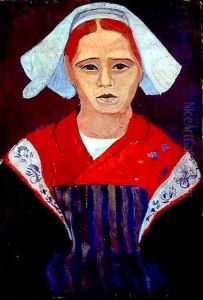Mogens Franscesco Hendrik Ballin Paintings
Mogens Ballin was a Danish artist and silversmith who had a profound impact on the development of Danish art at the turn of the 20th century. Born in 1871 in Copenhagen to a Jewish family, Ballin was exposed to the arts at an early age. His father was a merchant, which allowed Ballin a comfortable upbringing and the opportunity to pursue his interests in the arts. He initially trained as a painter but eventually became more renowned for his work in decorative arts, particularly metalwork.
Ballin was part of a circle of artists who were influenced by the Symbolist movement and the Arts and Crafts movement. He was particularly close to the Danish painter and poet J.F. Willumsen, who was a significant figure in Danish Symbolism, as well as to other artists of the period who sought to break from the traditions of the time. Ballin's own aesthetic was characterized by a synthesis of Symbolist ideals, with an emphasis on the spiritual and mystical, and the Arts and Crafts belief in the quality of materials and craftsmanship.
In 1893, he founded the Mogens Ballin Workshop, which produced metalwork of high artistic quality. This workshop became a gathering place for avant-garde artists in Copenhagen, and it helped to disseminate the ideas of Art Nouveau and the Arts and Crafts movement in Denmark. Ballin's metalwork often featured organic, flowing lines and was influenced by his interest in medieval art. He also had a strong interest in the reform of everyday objects, which he believed should be both functional and beautiful.
Tragically, Ballin's life was cut short when he passed away in 1914 at the young age of 43. Despite his early death, his legacy lived on in the work of his contemporaries and those who were inspired by his commitment to the unity of art and craft. The Danish Museum of Art & Design in Copenhagen houses some of his works, preserving the contributions of Mogens Ballin to Danish and European art history.
